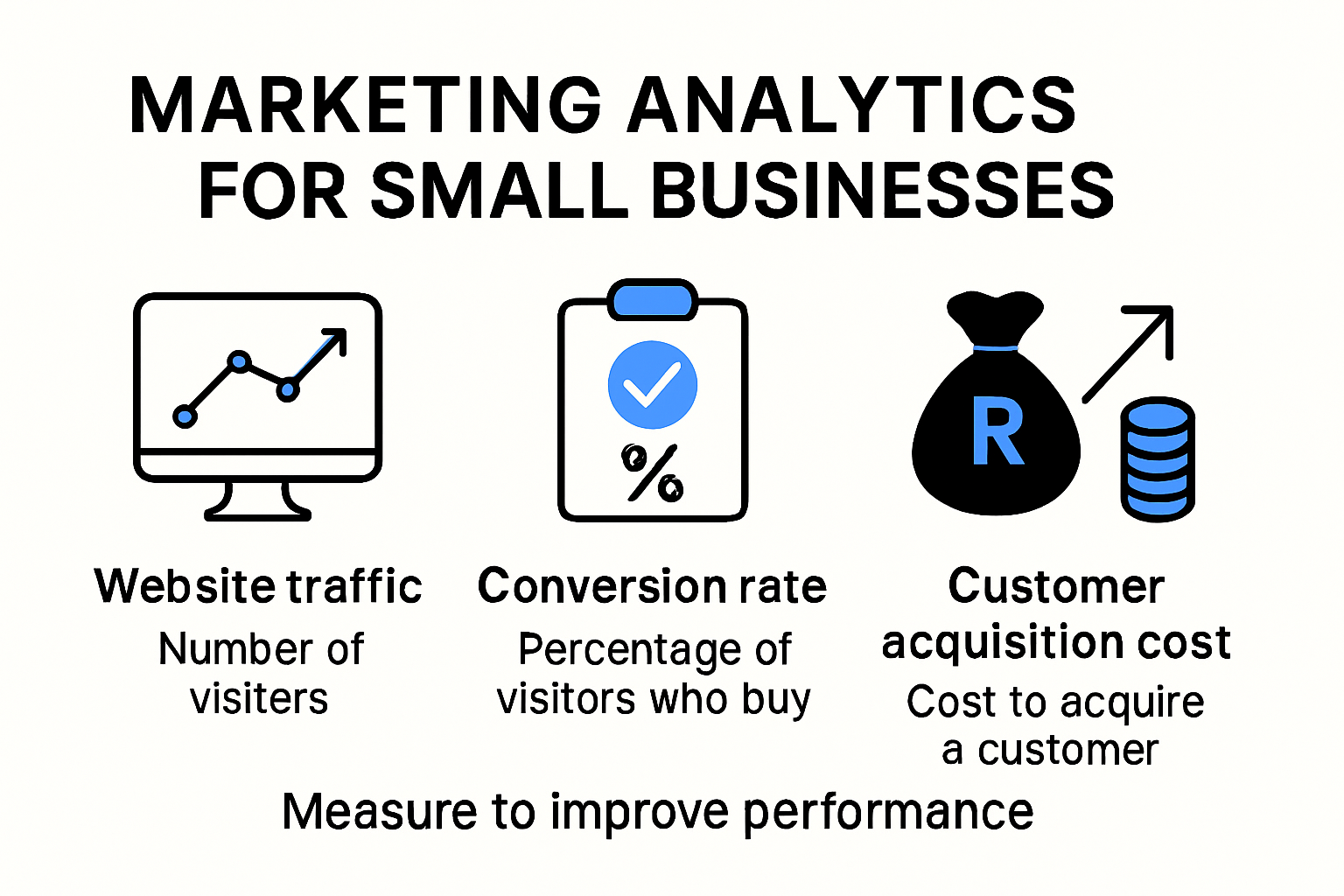Every small business owner tries to understand what actually works in their marketing. Here’s the wild part: businesses using marketing analytics grow revenue up to 20 percent faster than those who don’t. Most people think you need fancy software or deep pockets to get results, but the truth is even a small operation can turn simple data into real growth with the right approach.
Table of Contents
- Understanding The Basics Of Marketing Analytics
- Choosing The Right Analytics Tools For Your Business
- Tracking Key Metrics That Drive Results
- Using Analytics To Improve Your Marketing Strategy
Quick Summary
| Takeaway | Explanation |
|---|---|
| Leverage Marketing Analytics | Transform raw data into actionable insights to understand customer behavior and optimize marketing strategies effectively. |
| Select Suitable Tools | Choose analytics platforms based on budget, usability, and alignment with business objectives to enhance digital strategies. |
| Track Key Metrics | Focus on essential performance indicators such as Customer Acquisition Cost (CAC) and Customer Lifetime Value (CLV) to measure marketing effectiveness and drive growth. |
| Implement Data-Driven Strategies | Use insights from marketing analytics to create targeted customer segmentation and personalize marketing messages for better engagement. |
| Centralize Data Collection | Integrate data from multiple channels to develop adaptable marketing strategies based on comprehensive insights, ensuring responsive decision-making. |
Understanding the Basics of Marketing Analytics
Marketing analytics transforms raw data into actionable insights that help small businesses make strategic decisions. This powerful approach enables entrepreneurs to understand customer behavior, track marketing performance, and optimize their digital strategies with precision.
What Exactly is Marketing Analytics?
At its core, marketing analytics is the practice of measuring, managing, and analyzing marketing data to improve business performance. Harvard Business School Online defines it as a systematic approach to collecting and interpreting data from various marketing channels. For small businesses, this means turning complex information into clear, strategic guidance.
Small business owners typically track several critical metrics through marketing analytics:
- Website Traffic (understanding visitor origins and behaviors)
- Conversion Rates (measuring how effectively marketing efforts turn prospects into customers)
- Customer Acquisition Cost (calculating the expenses involved in attracting new clients)

Key Tools and Techniques for Small Business Analytics
Google Analytics provides an accessible entry point for small businesses wanting to understand their digital marketing performance. This free tool offers comprehensive insights into website visitor behavior, traffic sources, and user engagement patterns.
Understanding customer lifetime value (CLV) becomes crucial in marketing analytics. Alternative Opportunities Fund suggests that tracking CLV helps businesses prioritize high-value customer segments and develop targeted marketing strategies.
Effective marketing analytics requires businesses to:
- Collect Relevant Data: Gather information from websites, social media, email campaigns, and advertising platforms
- Analyze Patterns: Identify trends and correlations in customer behavior
- Make Data Driven Decisions: Use insights to refine marketing approaches
Transforming Data into Strategic Insights
Successful marketing analytics goes beyond simply collecting numbers. It involves interpreting data to understand customer preferences, predict future trends, and create more personalized marketing experiences. Small businesses can leverage these insights to compete effectively with larger organizations by making smarter, more targeted marketing investments.
By implementing robust marketing analytics practices, small businesses can:
- Reduce unnecessary marketing expenses
- Identify the most effective marketing channels
- Develop more precise customer targeting strategies
- Improve overall return on marketing investment
The key is to start simple, focus on meaningful metrics, and gradually build a more sophisticated analytics approach as your business grows and your understanding deepens.

Choosing the Right Analytics Tools for Your Business
Selecting the right marketing analytics tools can make or break a small business’s digital strategy. The complexity of modern marketing demands intelligent, adaptable solutions that provide clear insights without overwhelming users.
Understanding Your Analytics Requirements
Blackstone Consultancy highlights that small businesses must consider several critical factors when choosing analytics platforms. These include data integration capabilities, user-friendliness, scalability, and cost-effectiveness.
Key considerations for tool selection include:
- Budget Constraints: Identify tools that offer maximum value within your financial range
- Technical Complexity: Choose platforms matching your team’s technical expertise
- Specific Business Needs: Select tools aligned with your unique marketing objectives
Comparing Top Marketing Analytics Platforms
Decision Foundry suggests that advanced analytics platforms offering predictive analytics and AI-powered insights can transform small business marketing. Platforms like Google Analytics, HubSpot, and Mixpanel provide different strengths for tracking customer interactions and measuring campaign performance.
For small businesses seeking comprehensive insights, check out our guide on data and analytics services that can help streamline your marketing measurement approach.
Comparative analysis of popular tools reveals:
- Google Analytics: Free, robust website tracking
- HubSpot: Integrated marketing and CRM solution
- Mixpanel: Advanced user behavior analytics
Below is a table comparing the key features of top marketing analytics platforms mentioned, to help small businesses choose the most suitable tool for their needs:
| Platform | Cost | Main Features | Best For |
|---|---|---|---|
| Google Analytics | Free | Website tracking, traffic analysis | Entry-level website analytics |
| HubSpot | Paid | Marketing & CRM integration, automation | All-in-one marketing/CRM solution |
| Mixpanel | Freemium | Advanced user behavior analytics, funnels | Product & engagement analytics |
Implementing Your Analytics Strategy
Velainn recommends a strategic approach to tool implementation. Start by identifying key performance indicators (KPIs) relevant to your business goals. Free tools like Google Analytics can provide foundational insights into website traffic, while social media and email marketing platforms offer specialized tracking.
Successful implementation involves:
- Gradual Integration: Start with basic tools and expand capabilities
- Continuous Learning: Invest time in understanding platform features
- Regular Performance Review: Assess tool effectiveness quarterly
Pro tip for small businesses: Don’t chase complexity. Choose tools that provide clear, actionable insights without requiring extensive technical expertise. The goal is to understand your marketing performance, not get lost in data complexity.
Remember that the best analytics tool is the one you will consistently use and understand. Prioritize simplicity, relevance, and alignment with your specific business objectives when making your selection.
Tracking Key Metrics That Drive Results
Understanding and tracking the right marketing metrics is crucial for small businesses to measure performance, optimize strategies, and drive sustainable growth. These metrics provide actionable insights that transform raw data into strategic business intelligence.
Essential Performance Indicators for Small Businesses
OpenStax outlines several critical metrics that small businesses should prioritize. The most impactful metrics help entrepreneurs understand their marketing effectiveness and financial health.
Customer Acquisition Cost (CAC) emerges as a fundamental metric. This measurement reveals how much a business spends to attract each new customer. By calculating total marketing expenses divided by the number of new customers, businesses can assess the efficiency of their marketing investments.
Below is a summary table highlighting essential and advanced marketing metrics every small business should consider tracking, as described in the article:
| Metric | What It Measures | How It’s Used |
|---|---|---|
| Website Traffic | Volume/source of site visitors | Assess reach, optimise channels |
| Conversion Rate | % of visitors completing a desired action | Evaluate campaign or page effectiveness |
| Customer Acquisition Cost (CAC) | Cost to acquire one customer | Assess marketing spend efficiency |
| Customer Lifetime Value (CLV) | Total value generated by a customer over time | Prioritise high-value segments |
| Return on Marketing Investment (ROMI) | Revenue vs. marketing spend | Measure profitability of campaigns |
Advanced Metrics for Strategic Decision Making
Beyond basic tracking, sophisticated metrics provide deeper insights. Check out our data analytics services to understand how professional analytics can transform your business strategy.
Key advanced metrics include:
- Customer Lifetime Value (CLV): Calculated by multiplying average purchase value, purchase frequency, and customer lifespan
- Conversion Rate: Percentage of website visitors completing desired actions
- Return on Marketing Investment (ROMI): Measuring the revenue generated relative to marketing expenditure
Implementing a Robust Metrics Tracking System
Successful metrics tracking requires a systematic approach. Research from business analytics experts suggests implementing a comprehensive tracking framework that includes:
- Regular data collection and analysis
- Establishing clear benchmark targets
- Creating visual dashboards for easy interpretation
- Conducting quarterly performance reviews
Small businesses should focus on actionable metrics that directly correlate with business growth. Avoid getting overwhelmed by complex data. Instead, identify 3-5 key performance indicators that truly reflect your business objectives.
Practical tips for effective metrics tracking:
- Use free tools like Google Analytics for initial insights
- Set up automated reporting systems
- Train your team to understand and act on metric insights
- Continuously refine your tracking approach
Remember that metrics are not just numbers. They tell a story about your business performance, customer behavior, and market positioning. By consistently monitoring and interpreting these metrics, small businesses can make informed decisions that drive sustainable growth and competitive advantage.
Using Analytics to Improve Your Marketing Strategy
Marketing analytics transforms raw data into actionable strategies that propel small businesses toward meaningful growth. By understanding and interpreting customer behavior, businesses can craft more precise, effective marketing approaches that deliver tangible results.
Transforming Data into Strategic Insights
ResearchGate highlights that implementing marketing analytics enables small and medium-sized enterprises to make data-driven decisions, optimizing marketing strategies and enhancing overall business performance.
Key strategic approaches include:
- Customer Segmentation: Divide audiences based on behavioral patterns
- Personalization: Develop targeted messaging for specific customer groups
- Performance Optimization: Continuously refine marketing tactics based on data insights
Leveraging Social Media and Digital Channels
US Chamber of Commerce emphasizes that social media analytics provide critical insights into customer engagement and brand perception. By analyzing metrics like engagement rates, reach, and audience demographics, businesses can create more impactful marketing campaigns.
Learn more about our strategic digital marketing approach to understand how data-driven strategies can transform your business.
Effective social media analytics strategies involve:
- Tracking audience interaction patterns
- Identifying high-performing content types
- Understanding peak engagement times
Building a Data Driven Marketing Ecosystem
Successful marketing strategy requires a holistic approach to data integration. Small businesses must:
- Centralize Data Collection: Integrate insights from multiple channels
- Develop Predictive Models: Use historical data to forecast future trends
- Create Adaptable Strategies: Remain flexible and responsive to emerging insights
Practical implementation steps include:
- Regularly review and update marketing personas
- Conduct monthly performance reviews
- Invest in continuous team training on analytics tools
- Experiment with different marketing approaches based on data insights
Remember that marketing analytics is not about collecting endless data, but about extracting meaningful, actionable insights. Small businesses should focus on quality over quantity, selecting metrics that directly impact business growth and customer satisfaction.
By embracing a data-driven mindset, small businesses can compete effectively with larger organizations, making smarter, more informed marketing decisions that drive sustainable growth and customer engagement.
Frequently Asked Questions
What is marketing analytics?
Marketing analytics is the practice of measuring, managing, and analysing marketing data to enhance business performance. It helps businesses understand customer behaviour and optimise marketing strategies effectively.
Why is marketing analytics important for small businesses?
Small businesses using marketing analytics can grow their revenue up to 20 percent faster than those that don’t. It provides insights that inform strategic decisions and help optimise marketing efforts.
What tools should small businesses use for marketing analytics?
Popular tools for small businesses include Google Analytics for website tracking, HubSpot for integrated marketing and CRM solutions, and Mixpanel for advanced user behaviour analytics. These tools help gather critical marketing data and insights.
How can small businesses track key marketing metrics?
Small businesses should focus on essential performance indicators such as Customer Acquisition Cost (CAC), Customer Lifetime Value (CLV), and conversion rates. Establishing a robust metrics tracking system and using tools like Google Analytics can facilitate effective tracking.
Discover How Easy Marketing Analytics Can Drive Your Small Business Growth
Are you battling to turn your data into real business results? Small businesses often struggle with tracking key metrics like conversion rates and customer acquisition cost. The struggle to make sense of website traffic and marketing analytics leaves many feeling stuck and unsure of their next move. That is exactly where the right tools and strategy, as discussed in this article, become not just a nice-to-have, but essential for success in 2025.

Make your data work harder by partnering with specialists who truly understand small business marketing challenges. At Zoo Digital, we help you unlock advanced tracking, setup CRM integration and fine-tune every paid campaign. If you want to explore CRM platform options that turn your numbers into higher profits, visit our CRM Platform solutions. Ready to move from feeling overwhelmed to feeling in control? Take your next step with Zoo Digital and experience a smarter approach to marketing analytics. Act now to set your business up for data-driven success.
Recommended
- Zoo Digital | Data and Analytics Services South Africa
- Zoo Digital – Digital Marketing Strategy & Planning
- Shopify and GA4 – Our Solution to keep your data flowing – Zoo Digital
- Digital Marketing 2023 | Unlocking Growth with Zoo Digital
- Developing a Digital Marketing Plan: A 2025 Guide for Small Businesses | Ibrandmedia

